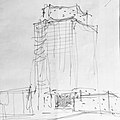Charles Edward Pratt
Charles Edward "Ned" Pratt (born July 15, 1911 in Boston ; died February 24, 1996 in Vancouver ) was a Canadian rower and architect.
Career
Noël de Mille and Charles Pratt represented Canada in a double scull at the 1932 Olympics in Los Angeles . There, four of the five boats started reached the final. The two Canadians won their run ahead of the Italians and the Brazilians. In the final, Kenneth Myers and William Gilmore from the United States won ahead of the German boat with Herbert Buhtz and Gerhard Boetzelen . Behind them the Canadians won the bronze medal in front of the Italians. Pratt rowed at the Vancouver Rowing Club and in the University of British Columbia boat until graduation .
After his career, Pratt began as an architect. Since the 1950s he was a partner in the architectural firm Sharp and Thompson, Berwick, Pratt founded by Sharp and Thompson in 1908 , which was later called Thompson, Berwick, Pratt and Partners . One of the structures designed by Pratt was the British Columbia Electric Company building in Victoria, completed in 1955 . The six-story modernist office building is also known as the Richard Blandish Building . The building has been on Canada's Historic Places list since 2008 . In 1957, the Electra Building, also designed by Pratt, was completed in Vancouver, where BC Hydro had its headquarters for a long time . This building was added to Canada's Historic Places list in 1993.
gallery
Web links
- Charles Edward Pratt in the Sports-Reference database (English; archived from the original )
Footnotes
- ↑ Volker Kluge : Olympic Summer Games. The Chronicle I. Athens 1896 - Berlin 1936. Sportverlag Berlin, Berlin 1997, ISBN 3-328-00715-6 . P. 737
- ↑ Thompson, Berwick, Pratt and Partners in canadianencyclopedia.ca
- ^ BC Electric Company Building on historicplaces.ca
- ^ Electra Building on historicplaces.ca
| personal data | |
|---|---|
| SURNAME | Pratt, Charles Edward |
| ALTERNATIVE NAMES | Pratt, Ned (short name) |
| BRIEF DESCRIPTION | Canadian rower and architect |
| DATE OF BIRTH | July 15, 1911 |
| PLACE OF BIRTH | Boston |
| DATE OF DEATH | February 24, 1996 |
| Place of death | Vancouver |




